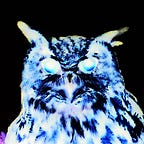Gail Ann Dorsey: The Superstar Hiding in Plain Sight
Bass players often strike me as cooler than most other musicians. If you need proof, here is the actual definition:
Gail Ann Dorsey is Exhibit A. She is not only one of the greatest ever on the electric bass, but she is an accomplished songwriter and multi-instrumentalist — she says the bass isn’t even her best instrument! To make it all even more unfair, has an amazing voice. And she always keeps her cool.
Dorsey’s father died when she was six, so she was raised by her mother, the last of several siblings. They lived hand-to-mouth, but Gail found a way to nurture her early love of music:
“I felt that whatever I had to do to be a musician in the world, whatever sacrifices I had to make, I’d do it.”
She learned to play guitar starting at nine years old, using borrowed instruments, and played in local cafes to gain experience. At 14, she borrowed a bass, never having played one, in order to answer an ad for a bass player. She got the gig, and eventually began to see herself as a bass player instead of as a guitarist.
At 17, she briefly enrolled in the California Institute of the Arts, which mostly emphasized filmmaking, and decided that music fit her temperament better:
“It takes a lot of time to make a film; whereas I could pick up a guitar and walk into a café with 10 people, sing a song, and see an immediate response. I realized that music is what I was really meant to do.”
Dorsey rapidly gained the attention of serious music people, for her songwriting, bass work and her singing voice. When she set out to make her own album, she ended up with Eric Clapton and Andy Gill (she would later return the favor and record an album with Gang of Four) on guitars, Steve Ferrone (of Tom Petty fame) on drums, and Carol Kenyon, among many, on backup vocals.
“The Corporate World”
(1988, title track from Dorsey’s first solo album)
The album got rave reviews, though it only had modest commercial success. Some critics have said if she had waited two or three years to release it, it would have caught the “alt rock” wave and been much bigger. One called it “The Pet Shop Boys…with soul.”
Dorsey continued a dual-track career, working on her own material, releasing a second album (she would eventually release three albums) and doing the session work for other acts. Some of those included Gang of Four, the Indigo Girls and the B-52s, ironically all acts who had previously featured, or would feature, another female bass phenom, Sara Lee.
Then, while prepping for a tour with Tears for Fears, Dorsey received a call that would completely redirect the rest of her career:
“Roland’s wife took the call in the kitchen and I can still see her now, racing across the driveway to the studio. She was ashen, and we were thinking ‘what has happened?’ And she said ‘Bowie just called and he is looking for Gail’.”
Dorsey joined David Bowie for a six-week tour, and never left. She was untutored, and could not read music, but would become the backbone of Bowie’s band for more than 20 years. She sang, played bass, contributed to composition and arrangements, and did what a bassist does — hold everything down when all hell is breaking loose.
“Under Pressure”
(1997, with David Bowie)
This performance knocks my socks off every time I watch it. I have it on good authority that singing while playing bass is tougher than singing while playing lead guitar (I wouldn’t know, I don’t play either.) If two people had split the duties it would still be amazing.
Since Bowie’s death, Dorsey has not slowed down, but has continued recording and touring with artists in many genres (blues, soul, country, pop, rock, funk). She worked for several years with Lenny Kravitz, and was a key participant in a number of David Bowie tribute concerts, often singing his vocal lines.
Most recently, Dorsey moved to France to work with French guitarist and bandleader Matthieu Chedid. One of the highlights of their encores is their covers of Bowie classics.
Gail Ann Dorsey had the gifts to be a superstar in her own right. She was not kept down or derailed, but chose to be a session player, and has made clear she has no regrets. She considers the 20+ year gig with Bowie to be the greatest gift she ever received professionally. That modesty notwithstanding, I think she truly was, and is, the superstar hiding in plain sight.
“Life on Mars” (2022, with Matthieu Chedid (“-M-“); original by David Bowie)
Sources:
Thanks to my friend Daniel G. for bringing Ms. Dorsey to my attention. As the title of the post suggests, she was right there in plain sight all those years, but now I know a bit of her story.
Andy Greene: “David Bowie Bassist Gail Ann Dorsey”, Rolling Stone, 2016 https://www.rollingstone.com/music/music-news/david-bowie-bassist-gail-ann-dorsey-he-altered-the-course-of-my-life-172271/
“Talking with Gail Ann Dorsey”, Guitars Exchange https://guitarsexchange.com/en/unplugged/350/gail-ann-dorsey/
Alex James Taylor: “Golden Years”, Hero Magazine, 2021 https://hero-magazine.com/article/189567/gail-ann-dorsey
Gail Ann Dorsey Facebook page
Robert Christgau: review of “The Corporate World”, 1989
Wikipedia entries on Dorsey, Bowie, Gang of Four, and “The Corporate World”
…….
Shout out to fellow travelers Terry Barr; Nicole Brown; Steve Goldberg; Charlie Cole; David Acaster; Alexander Razin; Miss Catherine La Grange, spinster; Jeffrey Harvey; Jessica Lee McMillan; Madeline Dovi; Elizabeth Kaldeck Smith; Drew Wardle; Buddy Gott; Steven Hale; Charlotte Ella King; Giulia Picciau. And thank you to Kevin Alexander for publishing!
